Dock10 rises to the challenge of the summer of sport
Its studios and facilities were on the air for 22 hours a day, every day throughout the Olympics
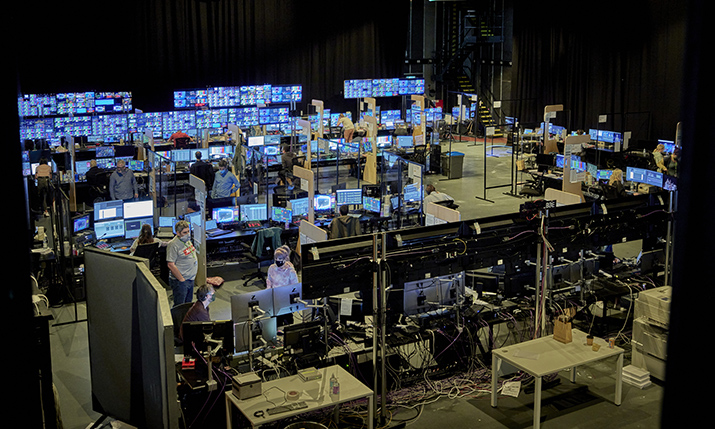
BBC Sport’s post production area for the Tokyo Olympics was at dock10 in the repurposed HQ2 studio
It has been non-stop action at dock10 this summer, and that’s not just the sport on the TV. BBC Sport has produced coverage for both the Euros and the Olympics from the Salford facility, with dock10 hosting the tentpole events through a combination of virtual sets, infrastructure upgrades, massive fibre roll out, working closely with OB companies, and transplanting most of an international broadcast centre to one of its studio floors.
“It’s been phenomenal,” says John O’Shaughnessy, head of technology operations. “It’s obviously been a very unusual year and it would have been unusual if we had done both of those events anyway because they would have been mainly done on location.”
Instead, BBC Sport coverage this summer took advantage of remote production technology and know-how at dock10. It is a trend that started back when the facility conducted trials with Arena for the 2020 FA Cup, and later when the Premier League football season started again in September last year.
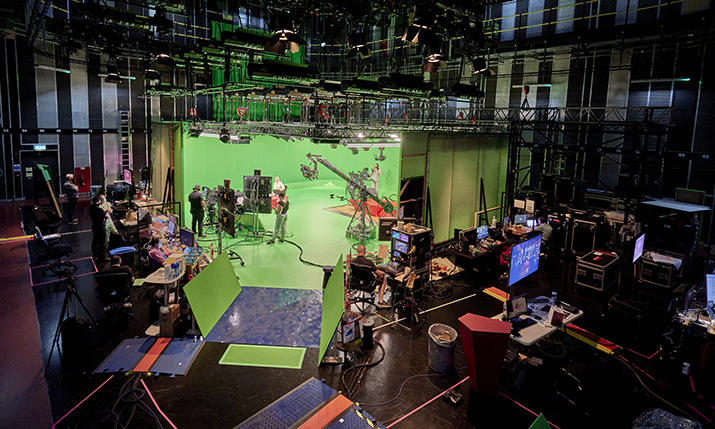
BBC Sport produced its Olympic content remotely from its studios at dock10 in Salford, UK, a first for the broadcaster on a Summer Games
“Football coverage has been migrating [towards remote production], but because of what’s happened with the pandemic it has led to a more centralised approach,” O’Shaughnessy says. “We are in a fortunate position of being very close to where BBC Sport is based. Their production people can just walk across the piazza [in Media City] from their office to our studio, and then deliver a production that could be anywhere in the world. The enabler there is the connectivity and, obviously, the equipment at each end that makes it happen. It’s good from the perspective of sustainability for kit and people, and has led to a great opportunity to work with those guys even more than we do already.”
“We’re used to being live on air with multiple studios, with lots of things coming in off the feeds, but covering live events and running highlights while live events are going on meant that effectively our studios and facilities were on the air for the best part of 22 hours a day, every day throughout 17 days of the Olympics”
The success of the trials with Arena and the rising demand for remote production first involved repurposing existing galleries, but the summer of 2021 also benefitted from a £1 million investment in a dedicated remote gallery solution. Based in Studio HQ8 it offers a production gallery for filming spaces around MediaCityUK, including the piazza, which is regularly used for live shows; and the ‘open centre’ at the front of the studios building. HQ8 also features a virtual set.
“We knew that the gallery might have to be used to deliver a live-to-air programme from the mezzanine level, or to deliver the FA Cup Final live from Wembley, as we did [with Arena in August 2020]. Given the number of sources that come back, the amount of IO that you need, then you need to expand. We put a Kahuna vision mixer in because we needed a desk that could handle different frame rates when we have multiple signals coming in. As long as you’ve got it fully loaded with all the various software, then it offers ‘any signal in any signal out’; it synchronises on the input, you can colour correct any signal and it gives you a lot of flexibility. We also put in a Calrec Artemis desk, knowing that it could deliver almost any production or remote production that we require.”
All dock10 studios have Calrec-based systems. “Calrec’s Hydra network system means that wherever those signals are we can deliver them to a gallery or our studio, and to air. At Media City, we effectively own and manage the whole fibre network on the whole campus and we’ve got 10 wall boxes scattered around the campus and the gardens. We can plug a microphone or camera into a wall box in the garden and patch that through to a Calrec desk in any studio.”
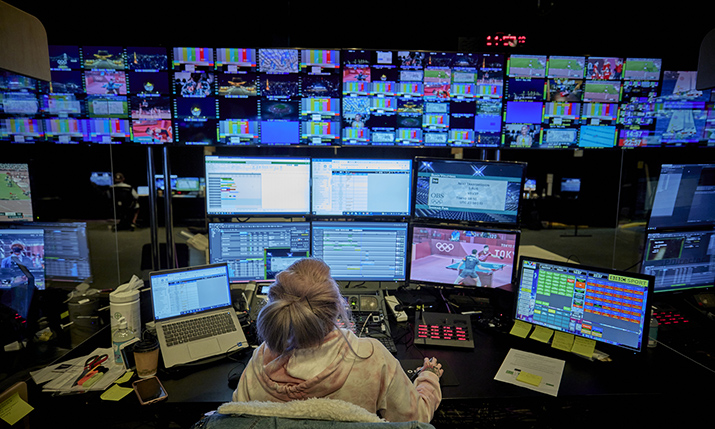 Football fervour
Football fervour
The Euros saw some coverage by BBC Sport using a remote production model at dock10, with Timeline sending cameras back to Salford along with associated audio over UEFA’s GigE circuits. COVID restrictions were in place throughout production, mainly concerned with social distancing and sanitising workstations.
“The Euros was reasonably self-contained because it was in a studio that we normally use for a lot of the sports presentation. But more spaces were being used,” says O’Shaughnessy.
“Some of our studio galleries are huge and expansive. The ones that are generally used for sport are a reasonable size but you can’t have five or six people on the same desk, shoulder to shoulder any longer. They have to all be on the show, somehow, so we had to think creatively about how to make this work. We had to split those teams up and use other spaces, effectively turning them into temporary galleries. We had to install talkback communications and all the feeds and all of the technical kit that needs to go with it, effectively having to have two sets of everything, and sometimes even more, to drive one space.
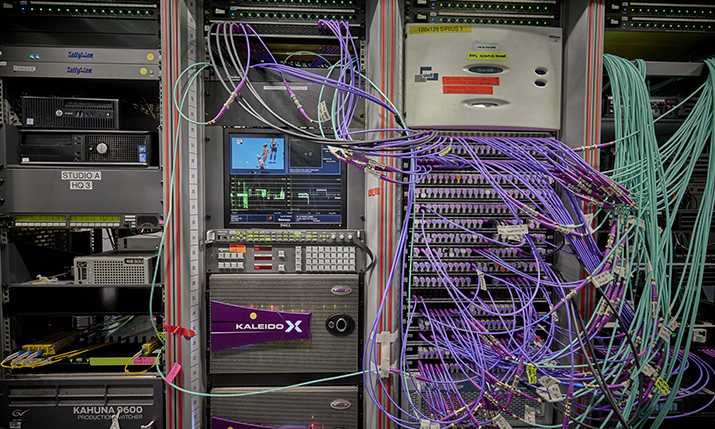
“We had to create a multiplex area where all the feeds came in and the production guys were able to pick out which game was going to be on and which highlights needed to be done. But they couldn’t be together – even in the edit suites, so you have one area where the editor is and one where the production person is. They effectively work as if they are in the same room, but they’re not. In this instance, they were in the same building, but having learned from a lot of remote editing we’ve done we just had to apply that further to the Euros.”
Virtual setting
The BBC’s main Euro 2020 broadcasts came from a specially designed virtual studio in dock10 that made use of a 180º 4K stadium feed from UEFA and live full-body 3D interviews with players and coaches ‘teleporting’ in.
The virtual set at dock10, designed with AE Live and BBC Sport, used Match of the Day’s traditional HQ7 studio, but the facility could have hosted such a set in any studio.
“We started with six camera-based virtual systems specifically for sport,” says O’Shaughnessy. “We’ve now got 12, and three more that we could set up quickly. We’ve standardised on the Mo-sys tracking system and the Zero Density Reality virtual studio system: all of our studios have the tracking stickers on the ceiling, so any of them can be used for virtual sets.
“With the Olympics, we had a very dramatic virtual set where they used three different parts of the studio with three different parts of the set, but physically all that was there was a couple of desks and a bit of floor”
“The Euros set has now been modified to become the Match of the Day set,” he adds. “It’s become the norm that on a Saturday, three sets go in [HQ7]: Football Focus followed by Final Score, followed by Match of the Day. Technically it’s the same facility, it’s just a [changing] file. There’s a little physical bit of the set, a table that changes, but the actual background and the floor and everything else associated with it gets turned on and off during the day.
“With the Olympics, we had a very dramatic virtual set where they used three different parts of the studio with three different parts of the set, but physically all that was there was a couple of desks and a bit of floor.”
Olympics gold
The Olympics is described by O’Shaughnessy as the, “Euros fivefold”. “Three years before Tokyo we didn’t know we were going to be involved in the event at all,” he says. “We knew we’d be doing some elements of it because of BBC Sport being so close, but most of it was going to be a Tokyo-based event. In the end, we had three studios dedicated to supplying various aspects of the [BBC coverage].”
“Most of the broadcast centre, the IBC that would have been settled in Tokyo was used on the floor of one of our studios,” he continues. “It had already been decided what the set up looked like in terms of equipment, so that had to stand. We had to build a secondary set of facilities for the IBC with all this [media] coming in from Tokyo and back out again, and then all of our presentation equipment, which was delivering the main transmission output to air.”
“It wasn’t just the BBC One and iPlayer at this IBC, the digital team, the team putting together the website and all the social media, were all part of that as well,” he adds. As a lot of the sport was going on through the night [UK time] there was a lot of editing going on for all the highlights packages that ran throughout the next day, so we had to create another area for all the postproduction.
“We’re used to being live on air with multiple studios, with lots of things coming in off the feeds, but covering live events and running highlights while live events are going on meant that effectively our studios and facilities were on the air for the best part of 22 hours a day, every day throughout 17 days of the Olympics.”
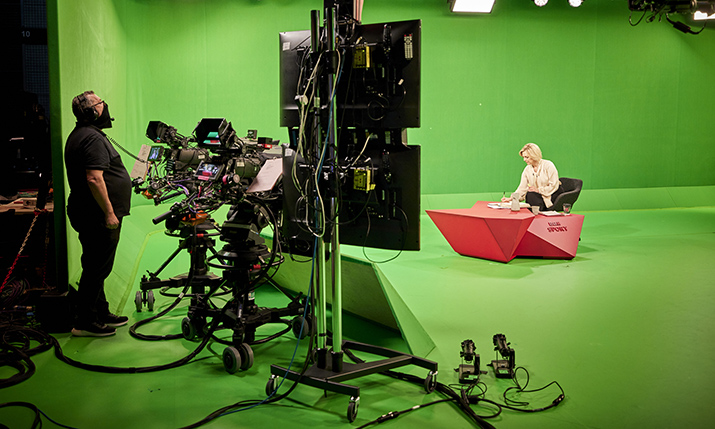
It took quite a while for the British public to grasp the fact that the impressive BBC Sport Tokyo Olympic studios were virtual, and coming to them from the UK
That came with some human challenges. “People can’t work all the time,” says O’Shaughnessy. “You’re still on air while you’re changing crews. When you have a change of operators, like audio mixers and vision mixers, you have to go through a process of sanitising workplaces.”
To support the BBC production, dock10 had to install masses of new fibre. “We had to run 10 lots of 24 core fibres to various parts of the building to expand our connectivity to be able to do the remote elements,” O’Shaughnessy explains. “So, for example, on the studio floor which became ‘the IBC’ we had to put in about 108 fibres to connect back to a central point. We added 27 bays of equipment to accommodate the IBC, in partnership with Dega Broadcast Systems and the BBC Sport team. Even a weekend into Olympics there was still more fibres and still more connectivity being added, as they might find a new location in Tokyo that they wanted to bring content in from, so we were adding to it all the time.”
As well as all the connectivity, dock10 also had to work out how to separate people due to COVID restrictions, using multiple galleries and multiple spaces to achieve what’s required.
“In one of our audio studios we built a dozen commentator booths, within sound-insulated boxes,” says O’Shaughnessy. “So while the cycling or the running was going on, all the commentators and their associated pundits, such as Paula Radcliffe or Sir Chris Hoy, would be next to each other in these insulated boxes, all effectively in the same studio. The coverage would be fed to them, and then that was sent back to the transmission feed. It seems quite bizarre how many signals we had to send there and back again to make it all work. But the benefit was that after the event was over, the pundit commentating just had to walk about 50 feet and they were in the presentation studio, live on air on BBC One, in vision, talking about how well, or otherwise, [athletes] had done.”
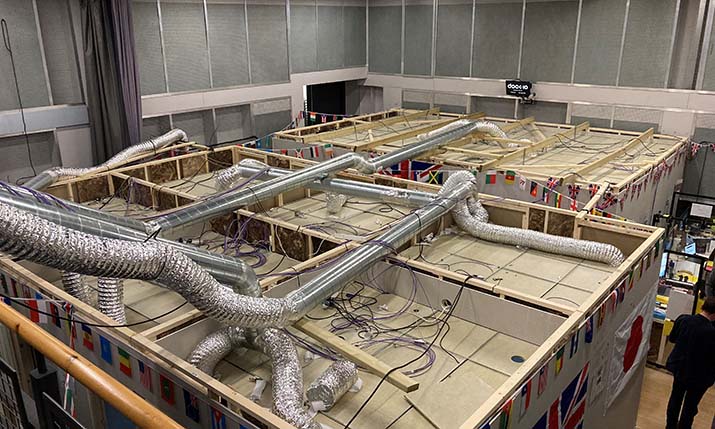
The commentator Multipurpose Audio Studio at dock10 is a series of small cubicles in the basement. BBC Sport used it for the Tokyo Olympics
So, while producing the Olympics did throw up some thorny issues, “they’re all really good challenges from our perspective, the type of work that’s involved, collaborating with a lot of other people, is a fantastic thing to do”, says O’Shaughnessy. “One of the things that BBC Sport recognised is the flexibility needed to deliver some of these events. There’s an element of knowing how to make these things happen. We have a superb team of people across the range, and it’s about the ability of that team to interpret what’s required with our technology to enable it and then to deliver what’s required.”
“The feedback we get from people has been so positive, it just means you want to do more of these events, however painful they are and how little sleep we’ve had with them”
One example is Galal Yafai, the first British boxer to win a gold at the Tokyo Games. “This guy has done really well to win his gold medal,” says O’Shaughnessy. “During his interview at the side of the ring, we hooked up a zoom call with his brother [boxer Kal Yafai], which came as a live feed into the studio, with Dan Walker as a presenter on the studio floor interviewing [them both]. This was just a whim that came up from the production team, and our team very quickly, within minutes, pulled this together.”
“We got some really good plaudits from the BBC team because they recognise the amount of work that’s involved [this summer],” he adds. “The feedback we get from people has been so positive, it just means you want to do more of these events, however painful they are and how little sleep we’ve had with them.”

